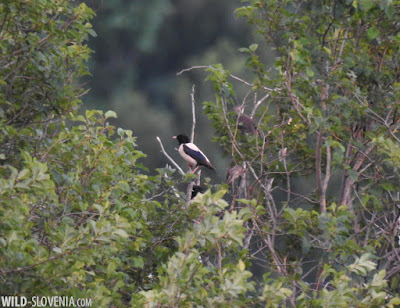 |
Rose-coloured Starling Pastor roseus, Škocjanski zatok NR.
Part of a flock of 14 birds among +800 Starlings Sturnus vulgaris. A big invasion of this rare species is underway around the Northern Adriatic, especially in nearby NE Italy and lower Austria. Big flocks on migration have also been observed through western Slovenia. |
 |
Bee-eater Merops apiaster, Landscape Park Strunjan.
This
pair nesting on a sandy bank in an orchard is a new breeding bird for
the park.
It also represents a new breeding site of this exotic and
localised breeder in Slovenia. |
 |
Barred Warbler Sylvia nisoria, Karst near Sežana.
A rare breeding bird in western Slovenia, with scattered pairs in the Karst.
This year we found three territorial males on the meadows of our local patch.
|
 |
Short-toed Eagle Circaetus gallicus, Karst near Sežana.
One of our local nesting individuals. |
Tawny Pipit Anthus campestris, Karst edge.
A very rare breeding bird in Slovenia, confined to the dry
limestone grasslands of the Karst.
 |
| Red-footed Falcon Falco vespertinus (female), Karst edge. |
 |
Nightjar Caprimulgus europaeus, Karst near Podgorje.
One of 13 singing birds recorded one evening during a census
of Scops Owl Otus scops. |
 |
Lesser Grey Shrike Lanius minor, Vipava valley.
Possibly the last breeding pair in the Vipava valley.
A very rare and sadly nearly-extinct breeder in Slovenia. |
 |
Black Kite Milvus migrans, Vipava valley.
A rare breeding bird in Slovenia, with at least one pair in the Vipava valley. |
 |
Red-backed Shrike Lanius collurio, Vipava valley.
|
Hoopoe Upupa epops, Vipava valley.
 |
| Lesser Grey Shrike census in the Vipava valley. |
 |
Turtle Dove Streptopelia turtur, Škocjanski zatok NR.
An increasingly rare breeding bird in Slovenia; one or two pairs
still nest at Škocjanski zatok. |
 |
Avocet Recurvirostra avosetta, Škocjanski zatok NR.
Up to 3 pairs of this rare and localised breeder have succesfully
raised their chicks at the reserve this year. |
 |
Kentish Plover Charadrius alexandrinus, Landscape Park Strunjan.
This season the species is breeding again at Škocjanski zatok NR after 12 years of absence with at least one pair, although up to 6 individuals have been observed. It is possible that we'll confirm more nesting pairs later in the season. The specie's only other breeding site in Slovenia are the Sečovlje salinas. |
 |
| Rock Bunting Emberiza cia, Landscape Park Strunjan. |
 |
| A recent highlight was helping our colleague Tomaž Mihelič from DOPPS (BirdLife Slovenia) to catch and satellite-tag a female Peregrine Falco peregrinus in the Karst. The
small device fitted to the bird is already revealing amazing data: this
individual regularly travels up to 30 km away from the nest on hunting
patrols! |
 |
| Peregrine Falco peregrinus - fledgling of the above female. |
 |
| Hay meadow in the Karst near Sežana (Mt. Nanos in the back). |
 |
| A rare scene in Slovenia. |
 |
| Meadow Brown Maniola jurtina on Bloody Pink Dianthus sanguineus, Karst near Sežana. |
 |
| Clouded Buff Diacrisia sannio, Karst near Sežana. |
 |
| Nickerl's/Assmann's Fritillary Melitaea aurelia/britomartis, Karst near Sežana. |
 |
Lulworth Skipper Thymelicus acteon, Landscape Park Strunjan.
The rarest of the Thymelicus skippers in Slovenia, largely confined to thermophilous
areas along the coast. Strunjan is the species' stronghold. |
 |
| Burnet Zygaena sp., Karst near Sežana. |
 |
Giant Peacock Moth Saturnia pyri, Karst near Podgorje.
Europe's largest moth, an impressive sight. |
 |
Scopoli's Longhorn Beetle Cerambyx scopolii, Karst near Sežana.
A common longhorn beetle in May and June; also regularly in the garden. |
 |
Violet Carpenter Bee Xylocopa violacea, Karst edge.
|
 |
Bladder Senna Colutea arborescens, Karst edge.
A rare Mediterranean plant in Slovenia, larval food plant
of the Iolas Blue Iolana iolas (also very rare). |
 |
Dittany Dictamnus albus, Karst near Sežana.
In full bloom on dry sunny meadows of western Slovenia.
|
 |
Adriatic Lizard Orchid Himantoglossum adriaticum, Karst near Sežana.
The plant in the second pic grows wild in our garden. |
Re-writing the same long post, after accidentally deleting it can be very difficult! Therefore here's only a selection of images with captions. Pretty busy lately with bird censuses - we've been in the field on a daily basis. Apart from rare birds and botany, there's also an increasing variety of butterflies, moths and other invertebrates to keep us busy. Hopefully more about that in one of the next posts. Stay tuned!







































